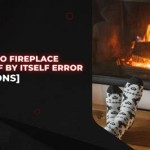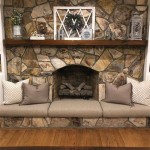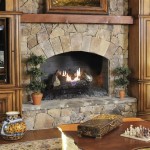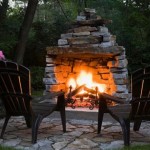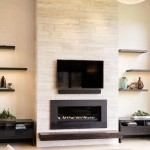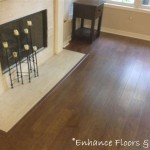Hanging a TV on a Stacked Stone Fireplace: A Comprehensive Guide
Mounting a television above a fireplace, particularly one adorned with stacked stone, presents a unique set of challenges and considerations. While visually appealing and space-saving, this installation requires careful planning, the right tools, and a thorough understanding of the structural integrity of the stone and the wall behind it. This article provides a detailed guide to successfully hanging a TV on a stacked stone fireplace, covering essential factors from preparation to execution.
Assessing the Suitability and Planning the Installation
Before initiating the installation process, a crucial first step involves determining if hanging a TV above the stacked stone fireplace is indeed a viable option. Several factors contribute to this assessment, including the type of stone used, the wall's composition, and the fireplace's functionality.
The type of stacked stone significantly impacts the difficulty of mounting. Natural stone, being denser and potentially uneven, might require specialized drilling techniques and mounting hardware compared to manufactured stone, which is often lighter and more uniform. Further, the depth and projection of the stone from the wall are critical. A shallower profile offers a more stable mounting surface. Excessive projection could necessitate longer mounting arms or spacers, potentially compromising the stability and appearance of the installation.
Equally important is ascertaining the composition of the wall behind the stacked stone. Common wall types include drywall, brick, and concrete. Drywall, while relatively easy to work with, offers the least structural support and requires anchoring to the wall studs. Brick and concrete provide a more robust base but necessitate specialized drill bits and anchors designed for masonry. Using the appropriate anchor type is paramount to ensure the TV remains securely affixed to the wall.
Another pivotal consideration is the fireplace's functionality. A working fireplace generates heat, which can potentially damage the TV's internal components over time. Elevated temperatures can shorten the lifespan of the TV and affect its performance. If the fireplace is frequently used, strategies to mitigate heat exposure must be implemented. This may involve installing a heat shield above the fireplace opening, opting for a full-motion TV mount that allows the TV to be pulled away from the wall when the fireplace is in use, or considering an alternative location for the TV altogether.
Furthermore, viewing height should be carefully considered. Mounting the TV too high can lead to neck strain and an uncomfortable viewing experience. Ideally, the center of the TV screen should be at or slightly below eye level when seated. This requires careful measurement and planning to determine the optimal mounting height, taking into account the height of the fireplace and the typical viewing position.
Finally, planning for cable management is essential. Exposed cables detract from the aesthetic appeal of the installation. Concealing the cables involves running them through the wall or using cable management solutions such as paintable cord covers. Planning for cable routing beforehand can save time and effort during the installation process.
Gathering the Necessary Tools and Materials
Once the suitability of the installation has been established and a plan formulated, gathering the necessary tools and materials becomes the next critical step. Having the right equipment on hand not only streamlines the process but also ensures a safe and professional-looking installation.
A high-quality drill is indispensable. For drilling through stacked stone, a hammer drill with a masonry drill bit is generally required. The size of the drill bit should correspond to the size of the anchors being used. It's also advisable to have a standard drill with various drill bits for pre-drilling pilot holes into wall studs if applicable.
Choosing the appropriate TV mount is crucial for safety and functionality. The mount should be VESA-compatible with the TV and rated to support its weight. Options include fixed mounts, tilting mounts, and full-motion mounts. A fixed mount provides the most secure and stable option but offers limited adjustability. A tilting mount allows for adjusting the vertical viewing angle, while a full-motion mount offers the greatest flexibility, allowing the TV to be swiveled and tilted in multiple directions. The choice depends on viewing preferences and the specific needs of the installation environment.
Selecting the correct anchors is paramount for securing the TV mount to the wall. For drywall, heavy-duty drywall anchors designed for high weight loads are necessary. For brick or concrete, concrete screws or sleeve anchors are the preferred choice. The weight rating of the anchors should significantly exceed the weight of the TV to ensure a safe and secure installation.
Additional tools that are typically required include a level (preferably a laser level for greater accuracy), a stud finder to locate wall studs, a measuring tape, a pencil for marking, a screwdriver (or drill with screwdriver bits), wire strippers, wire connectors, and cable management supplies such as cable ties and cord covers.
Safety equipment is also essential. Safety glasses should be worn to protect the eyes from debris during drilling. Gloves can help to improve grip and protect the hands. A dust mask is recommended to avoid inhaling dust particles, especially when drilling through stone or masonry.
Executing the TV Mounting Process
With the necessary tools and materials assembled, the actual TV mounting process can commence. This involves a series of careful steps to ensure a secure and aesthetically pleasing installation.
The first step is to accurately locate the wall studs using a stud finder. Marking the stud locations with a pencil is essential for aligning the TV mount. If mounting to brick or concrete, this step is less relevant but accurate measurement is still important to ensure proper anchor placement.
Next, the TV mount bracket should be positioned against the wall at the desired mounting height. Using a level, ensure that the bracket is perfectly level before marking the locations for the mounting holes. It is advisable to double-check the measurements and alignment to avoid errors.
Using the hammer drill with the appropriate masonry drill bit (if necessary), carefully drill pilot holes through the stacked stone and into the wall behind it. The depth of the holes should match the length of the anchors being used. When drilling through stacked stone, applying gentle pressure and using a slow, steady speed can help to prevent chipping or cracking.
Once the pilot holes have been drilled, insert the anchors into the holes. For drywall anchors, follow the manufacturer's instructions for installation. For concrete screws or sleeve anchors, use a hammer to gently tap them into place before tightening them with a wrench or screwdriver. Ensure that the anchors are firmly seated and securely fastened.
Attach the TV mount bracket to the wall using the appropriate screws or bolts. Tighten the screws securely, but avoid over-tightening, which could damage the wall or the bracket. Double-check the level of the bracket to ensure that it remains level during the tightening process.
Attach the mounting arms to the back of the TV following the manufacturer's instructions. Ensure that the mounting arms are securely fastened to the TV using the correct screws. Some TVs may require spacers to ensure proper alignment with the mount.
Carefully lift the TV and attach it to the wall-mounted bracket. Most TV mounts have a locking mechanism to secure the TV in place. Ensure that the TV is firmly locked onto the bracket before releasing it. Double-check that the TV is level and securely mounted.
Finally, connect all necessary cables, such as the power cord, HDMI cables, and any other audio or video cables. Conceal the cables using cable management solutions, such as cable ties, cord covers, or in-wall cable management kits. Ensure that all cables are neatly organized and out of sight.
After completing the installation, test the TV to ensure that it is functioning properly. Check the picture quality, sound, and all input sources. Make any necessary adjustments to the TV settings to optimize the viewing experience.
By adhering to these steps, a television can be successfully mounted above a stacked stone fireplace, enhancing both the aesthetic appeal and functionality of the living space.

Made How To Mount A Flat Screen Tv On Stone Fireplace Diy Stacked Fireplaces

Stacked Stone Fireplace With Tv Mount Fireplaces

Mounting A Tv Above Fireplace With Full Tutorial Fixthisbuildthat

Installing A Tv On Stacked Stone Wall

Installing A Tv On Stacked Stone Wall

Newest Snap Shots Fireplace Mantels With Tv Above Popular Stone The Th Brick Mantles Home Mantle Designs

Matt S Fireplace Design With The Tv Mounted Above Genstone

Mantelmount How To Mount Your Tv Above A Fireplace Infarrantly Creative

Mounting A Tv Above Fireplace With Full Tutorial Fixthisbuildthat

Fireplace Remodeling Options Classic Home Improvements Stacked Stone Fireplaces Remodel
Related Posts

